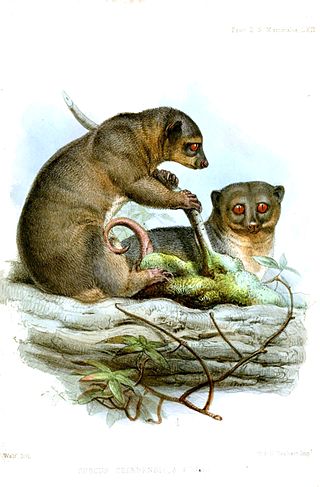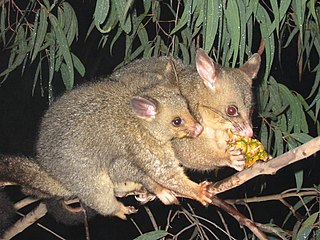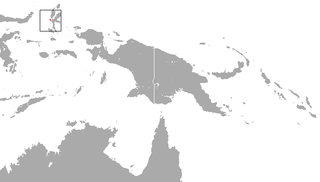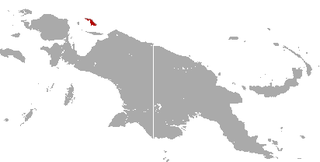
Phalangeriformes is a paraphyletic suborder of about 70 species of small to medium-sized arboreal marsupials native to Australia, New Guinea, and Sulawesi. The species are commonly known as possums, gliders, and cuscus. The common name "possum" for various Phalangeriformes species derives from the creatures' resemblance to the opossums of the Americas. However, although opossums are also marsupials, Australasian possums are more closely related to other Australasian marsupials such as kangaroos.

The Sulawesi bear cuscus, also known as the Sulawesi bear phalanger, is a species of arboreal marsupial in the family Phalangeridae that is endemic to Sulawesi and nearby islands in Indonesia. It lives in tropical moist lowland forest at elevations up to 600 m (2,000 ft) and is diurnal, folivorous and often found in pairs. A. ursinus is threatened by hunting, collection for the pet trade and deforestation.

The Gebe cuscus is a species of marsupial in the family Phalangeridae. It is endemic to the island of Gebe, North Maluku province, Indonesia, where it lives at elevations from sea level to 300 m.

The mountain cuscus is a species of marsupial in the family Phalangeridae found in West Papua, Indonesia and Papua New Guinea.

The ground cuscus is a marsupial from the order Diprotodontia and belongs within the family Phalangeridae, a diverse family consisting of the other cuscus species and the brushtail possums and the scaly-tailed possum.

The Woodlark cuscus is a species of marsupial in the family Phalangeridae endemic to Papua New Guinea, specifically on Madau and Woodlark Island, a part of the Milne Bay Province of Papua New Guinea. It happens to be the largest mammal living on Woodlark Island but it is also found on the neighboring island of Alcester, 70 kilometers south of Woodlark Island.

The ornate cuscus or Molluccan cuscus is a species of marsupial in the family Phalangeridae. It is endemic to Indonesia, where it is found on the North Maluku islands of Halmahera, Bacan and Morotai, at elevations from sea level to 1000 m.

Rothschild's cuscus, also called the Obi Island cuscus, is a species of marsupial in the family Phalangeridae. It is endemic to the islands of Obi, Bisa and Obilatu in the Obi Islands of Maluku province, Indonesia.

The silky cuscus is a species of marsupial in the family Phalangeridae. It is found in Indonesia and Papua New Guinea.

The Admiralty Island cuscus or Manus Island spotted cuscus is a species of marsupial in the family Phalangeridae. It is endemic to the Admiralty Islands of Papua New Guinea. It is the smallest member of the genus Spilocuscus, and the female has a black back, while the male has blackish spots on a white background. Both genders have rufous heads.

The Waigeou cuscus or Waigeou spotted cuscus is a species of marsupial in the family Phalangeridae. It is endemic to the island of Waigeo in Indonesia, and consequently the spelling Waigeo cuscus is often used instead of Waigeou cuscus. Unlike all other members of the genus Spilocuscus, both genders are whitish with black spots. It remains fairly common, but its small range makes it vulnerable to habitat loss and hunting.

The black-spotted cuscus is a species of marsupial in the family Phalangeridae. It is among the largest members of the family, only being surpassed by the bear cuscus. It is a relatively colourful species found in forests of northern New Guinea. It is threatened by hunting and habitat loss, and has already disappeared from large parts of its range. Consequently, it is rated as Critically Endangered by IUCN.

The Sulawesi dwarf cuscus is a species of arboreal marsupial in the family Phalangeridae that is endemic to Sulawesi and nearby islands in Indonesia. It inhabits tropical moist lowland forest and is nocturnal, folivorous and usually found in pairs. S. celebensis is threatened by hunting and deforestation.

The Banggai cuscus is a species of cuscus, a type of possum. It is found in the Peleng and Sula Islands to the east of Sulawesi in Indonesia.

The Talaud bear cuscus is a species of marsupial in the family Phalangeridae. It is endemic to Salibabu Island in the Talaud Islands, Indonesia. Its natural habitat is subtropical or tropical dry forests. The species is considered Critically Endangered, with a small population size and heavy hunting pressure on both islands where it occurs, as well as continued habitat degradation.

The Phalangeridae are a family of mostly nocturnal marsupials native to Australia, New Guinea, and Eastern Indonesia, including the cuscuses, brushtail possums, and their close relatives. Considered a type of possum, most species are arboreal, and they inhabit a wide range of forest habitats from alpine woodland to eucalypt forest and tropical jungle. Many species have been introduced to various non-native habitats by humans for thousands of years.

The blue-eyed cuscus is a species of marsupial in the family Phalangeridae. It is endemic to the two small islands of Ternate and Tidore, west of the island of Halmahera in North Maluku province, Indonesia.

The blue-eyed spotted cuscus or Biak spotted cuscus is a species of critically endangered marsupial in the family Phalangeridae.


















